
 |
Home | Upper Mustang Main | Contact |
Updated: June 2010
The following reference information is included:
My rating scale:
 Excellent ;
Excellent ;
 Very Good ;
Very Good ;
 Good ;
Good ;
 Fair ;
Fair ;
 Poor.
Poor.
Click on an image to see the FULL size with a caption.


by Stan Armington. A classic trekking book detailing with good maps and route descriptions all of the favourite Nepalese treks, including Gokyo and Everest, Annapurna, Kangchenjunga, Manaslu, and Upper Mustang.
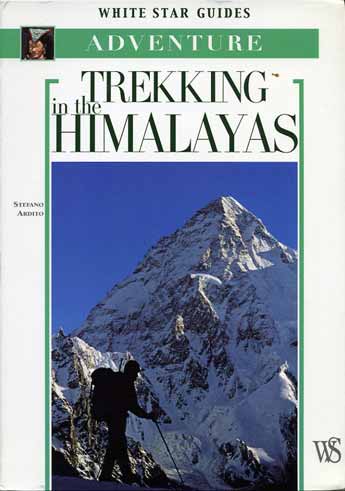
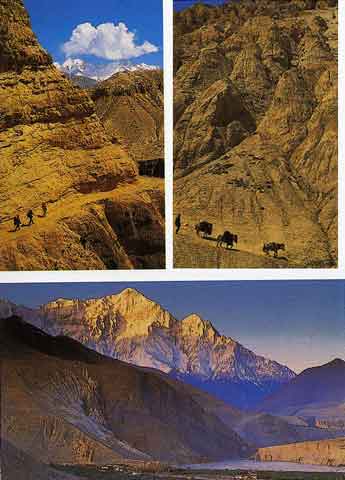

by Stefano Ardito. Published 2006. This trekking guidebook contains basic descriptions of 15 treks: Tirich Mir, Kafir Valleys, around Nanga Parbat, traversing the Biafo and Hispar Glaciers, K2, Zangskar, source of the Ganges, Kailash, Annapurna Sanctuary, around Annapurna, Upper Mustang, Langtang and Helambu Valleys, Everest Nepal, Everest North ABC and Kangshung East Face, and Chomolhari. Each trek has an overview, useful information, a map and a day-by-day description. There are almost 250 photos. The cover is K2.
There are 8 pages on the trek from Pokhara to Kagbeni to Lo Manthang in Upper Mustang.
The maps and photos are very good.

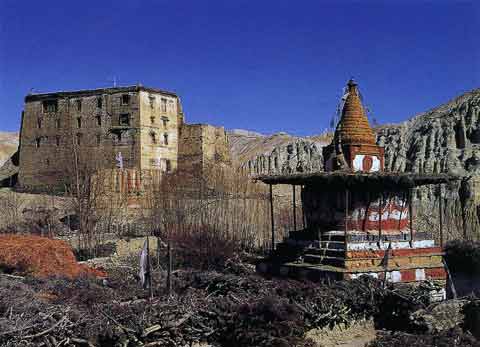

by Steve Razzetti. This book contains basic information on 25 treks in Nepal, including Humla to Mount Kailash, the Annapurna Sanctuary and Circuit, the Dhaulagiri Circuit, Jomsom to Upper Mustang, Around Manaslu, Rolwaling, Gokyo and Everest, Makalu, and Kangchenjunga. It also contains descriptions of climbing 12 trekking peaks, including Pisang, Chulu, Ramdung, Lobuche East, Imja Tse, and Mera. The front cover is Annapurna South.
The book includes four pages on Jomsom to Upper Mustang.
The trekking route descriptions and maps are basic. The photos are very good.
My favourite Upper Mustang and Lo Manthang books:

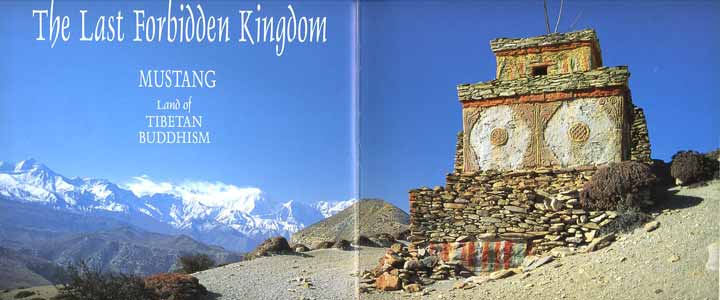

Photographs by Vanessa S. Boeye, text by Clara Marullo. First published 1995. The authors visited Upper Mustang just after it was opened for tourism in 1992. There are over 150 photos, about a third full page or larger.
Marullo gfives a brief overview of Upper Mustang's history and describes the trek to Lo Manthang. The way of life is detailed including nomads, the role of the King, details of village and family life, children, education, weddings, doctors and death, livestock, and planting and harvesting crops. Buddhism is woven into the fabric of everyday life with Marullo detailing the spectacular monasteries filled with masterpieces of Tibetan religious art. She closes with a diuscussion on conservation and tousism.
If you are going to buy only one book before trekking to Upper Mustang, this is the book. The photos are spectacular. The text is fairly basic, but excellent as an overview.
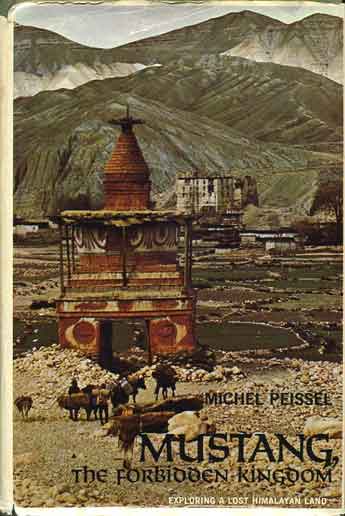
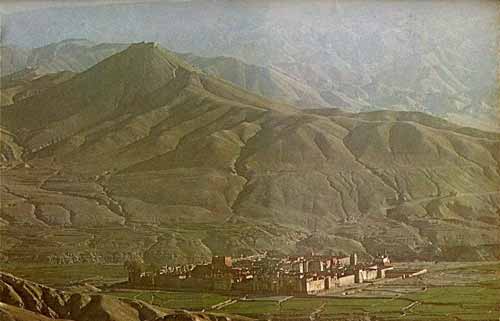

by Michel Peissel. First published 1967. In 1964 the author became the first European to be allowed into Upper Mustang for an extended stay. Peissel, who could speak TIbetan, lived in the walled capital city, Lo Monthang, and became close friends with many inhabitants which allowed him to not only observe, but truly become a man of Lo. There are 12 pages of colour photos, 11 pages of b/w photos, 8 drawings, and 3 maps. The front cover is the entrance chorten to Tsarang.
Peissel was accompanied by Tashi, a 21-year-old Tibetan born in Amdo, and Calay, his cook and sirdar. The book starts with a flight to Pokhara and trekking up the Kali Gandaki Valley. Along the way he met Khampas, who were still fighting the Chinese in Tibet from their bases in Upper Mustang. At Tsarang he met the abbot of the Gompa, who turned out to be the King’s son on an extended retreat. He then explored Lo Monthang and the surrounding areas. He met the 65-year-old King and his sick son, Jigme Dorje, who is now the current king. Peissel learned about the people and their culture, like birth, marriage, medicine and doctors, and death and funerals. After searching in vain for an old book with the history of Upper Mustang, he finally discovered one at a gompa, and can then price together the first known history of Upper Mustang.
This is a very good book of exploration and discovery. Perissel's writing is fairly straightforward, but the story itself is very interesting. I especially liked his insights into the people and their culture. The photos are good.
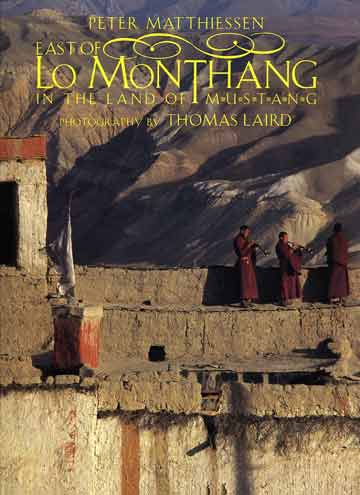


text by Peter Matthiessen, photographs by Thomas Laird. First published 1996. A coffee-table photographic book detailing the authors' trip to Upper Mustang and Lo Manthang in May 1992. There are over 156 photos, 68 a full page or larger. The front cover is Lo Manthang.
The authors travel from Jomsom to Kagheni, with an interesting description of the ghost eaters, and then up the Kali Gandaki River route, where they visit a remote gompa and meet the nomads who live in the area. The monks and local people tell stories of the mehti (Yeti), but no sightings or evidence is found. Snow leopards do exist and kill some of the animals. They then visit Lo Manthang and attend the Tiji Festival. We see the people harvesting, attend a wedding, and meet the King and his wife, Tashi Tenzing, the abbot of Chodi Gompa, and the local Tibetan medicine man.
Matthiessen describes Lo Manthang: "With its twenty-foot high surrounding wall and its sentinel turrets at each corner, with its prayer flags and white central palace and red temples, Lo Monthang seems formidable and enormous by comparison to the other isolated settlements we have passed through, yet this medieval town on its remote desert plateau is thought to have just one hundred and eighty households, and les than one thousand inhabitants, and one could circumambulate the city walls four times in an hour, as King Jigme Palbar Bista, on his royal constitutional, is said to do at sunrise every morning."
Matthiessen desribes the Tiji Festival: "The costumes and masks, the twelve-foot horns, the gold cups of wheat, the butter cakes, the snow peaks and wind and dust and sun, the mehti, snow leopard, snow pigeons, saligrams, the dying glacier and the desert ruins, the drunks and rajas and foreigners, the dogs and yaks. Tantra!"
The photos are excellent, especially those of the Tiji Festival, Lo Manthnag from overhead, and inside the temples. The writing is wonderfully descriptive, especially of the Tiji Festival.
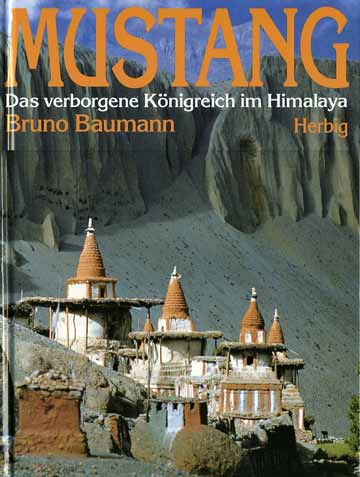
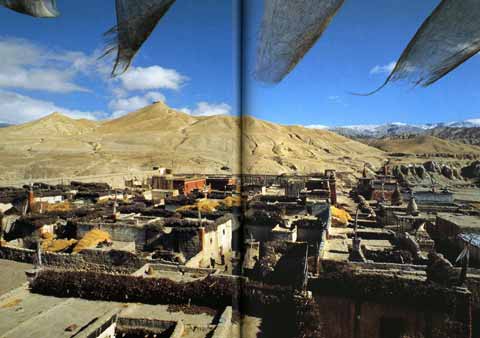

by Bruno Baumann. First published 1993. Large coffee-table book with lots of text in German. There are 146 photos, including 23 2-page photos and 30 full-page photos, and 3 maps. This book was republished by National Geographic in 2004 in a small paper-back format with only 16 pages of photos.
This book documents Baumann's visits to Upper Mustang in the summer of 1992 and February 1993. He documents the trek and Lo Monthang including the sights, the people, Buddhist practices, the Tiji Festival, and meeting the King. He also trekked to the souce of Kali Gandaki and climbed Kang Gongaria (6180m).
This is a very good photographic account of Upper Mustang. You may not be able to read the detailed German text, but the photos speak for themselves.
My favourite books that partially feature Upper Mustang and Lo Manthang are:
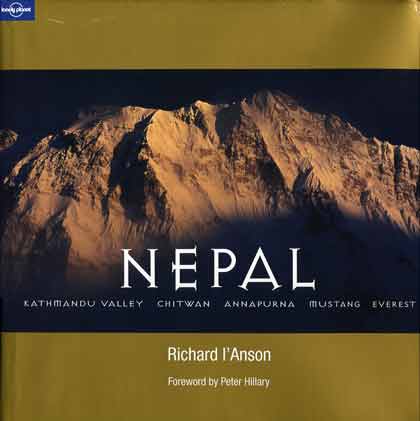
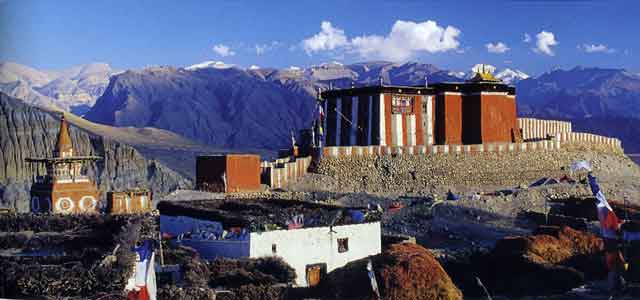

by Richard I'Anson. First published 2007. A large coffee-table type book featuring over 400 photos from renowned photographer Richard L’Anson. Chapters include Kathmandu and Kathmandu Valley (112 pages), Chitwan (20 pages), the Annapurna Circuit and Sanctuary (54 pages), Upper Mustang (20 pages), and the Mount Everest Khumbu region (51 pages). The front cover is Annapurna South Face.
Lower Mustang in the Mustang chapter is actually part of the Annapurna Circuit, and features Muktinath, Jharkot, Kagbeni, Jomsom, and Marpha.
Part of the Mustang chapter features Upper Mustang from Kagbeni to Lo Manthang. Villages featured include Chuksang, Chele, Ghemi, Charang, Lo Manthang, Drakmar, and Tama Gaon.
This is my favourite Nepal photo book. It features all of the main tourist areas. The photos are spectacular.

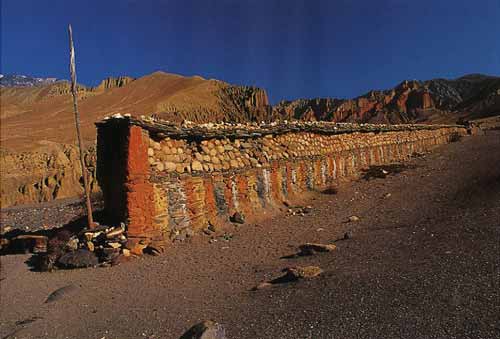

by Andrew Stevenson. Published 2002. The author of the Annapurna Circuit Himalayan Journey travelogue produces a photographic journey of the Annapurna Circuit and Sanctuary and Upper Mustang, with an overview of each section of the trek.
There are 35 pages of photos of Upper Mustang, over half full page or larger.
Stevenson provides a good description of the trek and includes very good maps. The photos are very good.
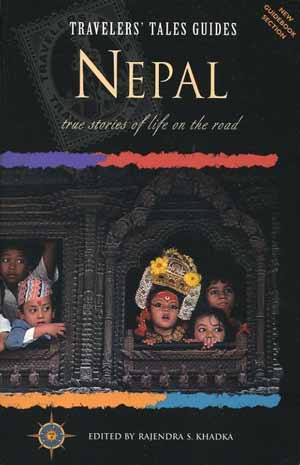

Editors - James O'Reilly) and Larry Habegger. Another in the Travelers series of travel anthologies, this time capturing the experience of Nepal.
The book is organized into five sections: Essence of Nepal, Some Things to Do, Going Your Own Way, In the Shadows, and The Last Word. Some of the authors include Broughton Coburn, Ian Baker, Jeff Greenwald, Jimmy Carter, and Tim Ward.
I especially like Coburn's story, called A Nosy Neighbor, about a leech. I always think of this story whenever I read about leeches on the trekking trails.
I am a fan of the Travelers Tales series and find that they provide more memorable ideas about a place than just reading a guide book.
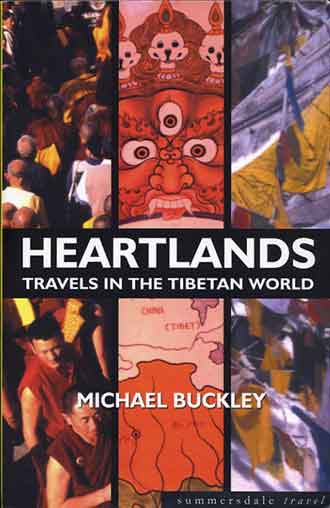

by Michael Buckley. Published 2002. After interviewing the Dalai lama in 1989 in Dharamsala, Buckley vowed: "I want to see as much as I can of the Tibetan world before the flame is snuffed out, to get cracking before it all disappears. Because according to the Dalai Lama, it’s on the brink – and he should know." Buckley relates 13 trips from 1989 to 1999 through the areas of Tibetan culture - Tibet, Ladakh, Dharamsala India, Outer Mongolia, Nepal, Bhutan and Sikkim.
The stories are: bicycling the high passes of Ladakh; Dharamsala and a chat with the Dalai Lama; through Mongolia and Amdo; visiting Lhasa; taking landcruiser tours near Lhasa; acting in a Chinese movie about the British invasion in Gyantse; visiting Guge Kingdom in western Tibet; trekking around Mount Kailash; trekking to Upper Mustang in Nepal; teaching young Tibetan refugees English near McLeod in India; a humourous account of a best selling autobiography of a Tibetan Lama from 1956 whose author turned out to be a fake; Bhutan; and Sikkim visiting Darjeeling, Gangtok and Kalimpong to see Kangchenjunga.
Buckley trekked to Lo Manthang in Upper Mustang in October 1995, where he had tea with the King. "The wind has, over the millennia, sculpted the canyon walls into surreal shapes – organ-pipe cliffs, fluted pillars, rock spires. Striking bands of colour appear in the hills: blue, grey, rust and green tones. ... The crystal clear vistas redefine your sense of space. Under piercing blue skies, this awesome display of wilderness resonates right through your bones, a high-altitude tonic."
I enjoyed Buckley's writing style, informative, insightful, humourous and entertaining. Like the Travelers series, this book is a great companion to travel guides before traveling to Tibetan areas.
There are a few informational Upper Mustang websites, with my favourites being:
I thoroughly enjoy reading other people's travelogues and looking through their photos. Here are my favourites on Upper Mustang:
There aren't many videos on Upper Mustang. Here are the ones I found:
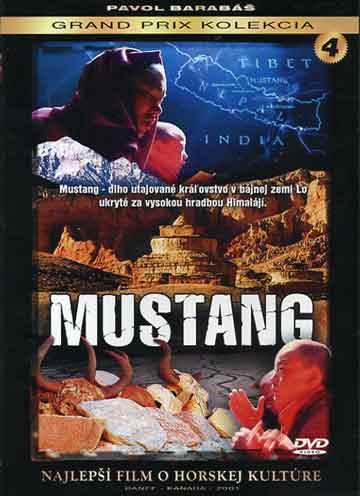
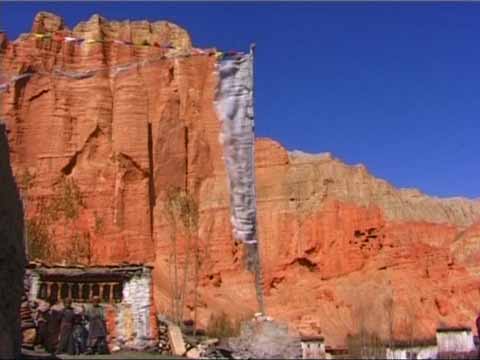

by Pavol Barabas. This DVD has three documentary films in Slovak and English. The other two are Buddhism On The Roof Of The World (1998, 23 minutes) and Their Home Is Below Kangchenjunga (1998, 25 minutes). Released 2001. 27 minutes. Extras include Making Of (7 minutes), a Photo gallery (6 minutes), and background on Pavol (10 minutes) and his films.
Mustang documents Pavol's trek in May 2000 from Besishar to Manang, over the Thorung La and up to Lo Manthang. You need special permission to video in Upper Mustang, so Pavol smuggled his small camera in. The film shows the people and their daily life like plowing, spinning wool, looking after livestock, Buddhism is highlighted with monks blowing horns, chanting, and reading sacred texts. Prayer wheels and chortens contrast with the desert scenery. When Pavol visits the king, he admits he is making a film. The king simply says it is Pavol's karma. Pavol: "It was built at the beginning of the fourteenth century, and those 300 people live there today the same way as people did 700 years ago."
The scenery is spectacular and well filmed, bringing out the reds in the cliffs, the blue of the sky, and the green of the fields. The narration and background music are very good. I especially liked the village scene when an old woman laughingly asks him, “Are you white all over?” The Lost Treasures Of Tibet video is a perfect companion to this film, because it shows inside the monasteries with their statues and paintings.
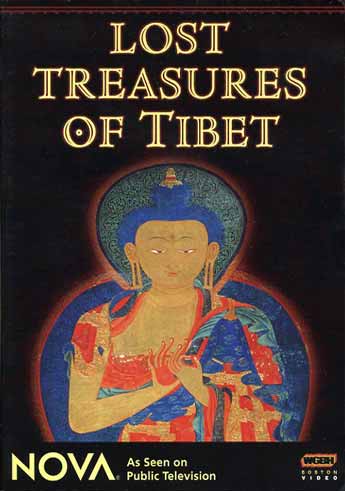
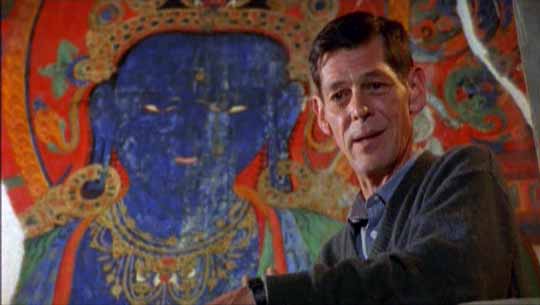

Produced, directed, and partially written by Liesl Clark. Released 2003. 55 minutes. Narrrated by Liev Schreiber. Nova. pbs.org has lots of extra information, including the transcript, the paintings before and after restoration, a map and photo gallery.
Nova traveled to Lo Manthang in Upper Mustang in 2000 and 2001 to follow British architect John Sanday and art conservator Rodolfo Lujan from Rome as they work with local townspeople to try and restore the abandoned Thubchen Gompa and its paintings. John: "I began to realize how fantastic the wall paintings actually were. They are fifteenth century, they are priceless. These are masterpieces."
The film opens with Lama Guru Gyaltsen, a Tibetan monk, traveling on horseback up the Kali Gandaki valley. He stops at a cave where deities are said to emanate from the walls, and attends a Buddhist festival to ward off evil forces. John leads the restoration of the Gompa roof, in the traditional way with wood, flat stones and mud. Rodolfo leads the restoration of the paintings using the same techinques as the Sistine Chapel. Lama Gyaltsen and the King are pleased with the restoration, but ask the conservators to go even further and fill in the gaps and cracks in the paintings.
This is an excellent film of the restoration of Tbubchen Gompa and its paintings. There is a flyover of Lo Manthang, showing the makeup of the village. The Pavol Barabas film Upper Mustang is a perfect companion to this video because it highlights the spectacular scenery and everyday life in Lo Manthang.
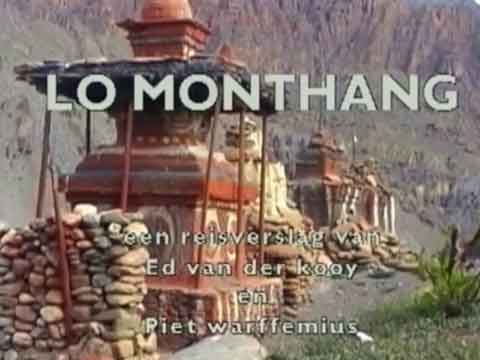
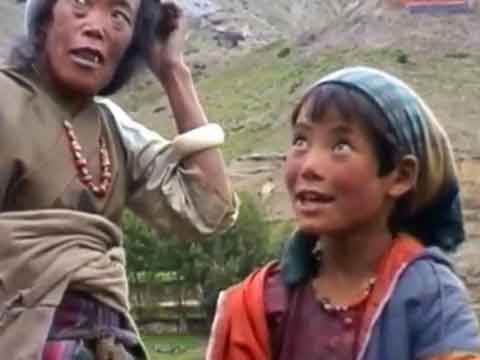
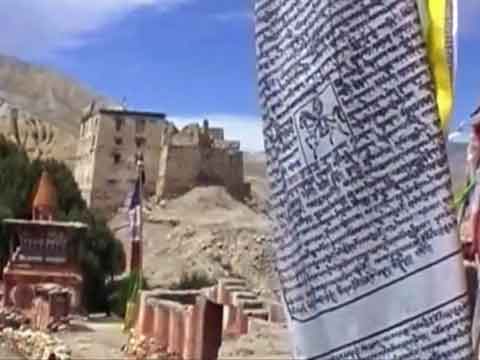

by Ed van der Kooy and Piet Warffemius. This 51-minute video on Youtube in six parts shows their 1998 trek up the Kali Gandaki valley to Kagbeni, Chele, Geiling, Tsarang and Lo Monthang in Upper Mustang. When interviewed, Ed speaks Dutch.
The filming is very professional, with lots of focus on the local villagers and the gompas along the way. The pace is nice and slow, peaceful, quiet - kind of like prayer flags flapping in the wind, or maybe just like trekking. The background music is perfect.
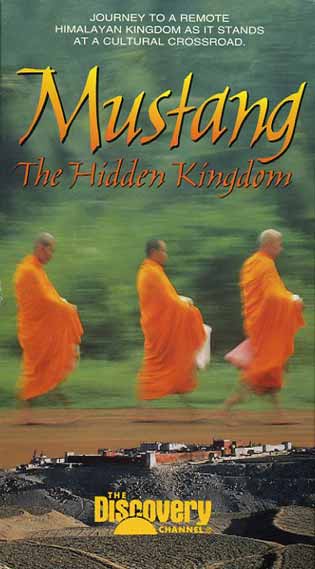
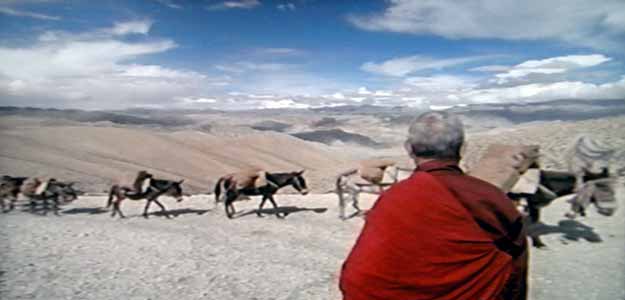

Directed by Tony Miller. Produced by Vanessa S. Boeye. Written by Clara Marullo. Shown on TV in 1994. 101 minutes. Discovery. Narrated by Harrison Ford. This film follows Khamtruel Rinpoche on a three-month journey from Dharamsala to Upper Mustang in the summer of 1993 "to offer advice, guidance, and religious teaching to the people of Upper Mustang." He will also bring two young boys back to Dharamsala to receive a traditional Buddhist education.
The video opens with scenes of the Rinpoche getting ready to leave Dharamsala and having one last visit with the Dalai Lama. The Rinpoche then flies to Jomsom, and rides on horseback up the Kali Gandaki valley. He encounters Upper Mustang's deeply religious inhabitants, and gives them simple but direct advice and teachings. He also repeatedly pleads with Pasang, the lead horseman of the expedition, to give us his drinking and look after his family.
The Rinpoche finally arrives at Lo Manthang and is greeted by all the villagers and the King of Upper Mustang. He speaks to the villagers and plays a message from the Dalai Lama. The Rinpoche walks through the alleys of Lo Manthang, and visits the gompas and Pasang's house. The Rinpoche breaks down and cries as stares into Tibet, "This is the landscape of my childhood. The mountains, the silence, the vast spaces." The two young boys travel to Dharamsala with their fathers, and have a brief visit with the Dalai Lama before joing the other students at school.
I especially enjoyed seeing the Dalai Lama and the villagers and their way of life. Good filming. Very good narration. Because this was filmed in the cloudy summer, the scenery is a little washed out. I thought the film could have been tighter, maybe half the length, eliminating the same kind of scenes like the Rinpoche meeting the villagers.

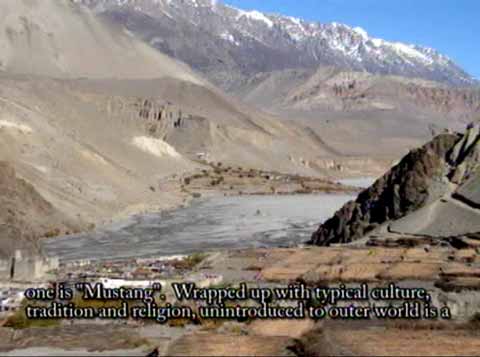

by Ghang-Tuk Tsokpa. Released 2001. 54 minutes. In Tibetan with English subtitles. After an overview of Mustang history, culture, geography, horses and yaks, Buddhist beliefs, and food, the film describes Mustang life during the four seasons of the year.
In the winter the children enjoy playing in the snow and ice while the adults spin wool and weave clothing. After the Losar new year ceremonies and celebrations, they plant seeds and tend the soil. In Spring there is a festival to ward off epidemics with archery contests, and another one to celebrate elders who are over 60.
In summer people help each other during the harvest and store away grass for the winter. There is a festival in August at Muktinath to celebrate the end of the harvest with horse racing and dancing; and another one in September with masked dances to pray for world peace. In Autumn they harvest potatoes, buckwheat, and apples. Many people leave Mustang for Pokhara and Kathmandu to trade and avoid the cold winter weather.
This is not a tourist video. It does present a good overview of the Lower Mustang people, their festivals and activities throughtout the year. The filming has a home movie feel, a bit unsteady, and slightly fast pans and zooming. The background music is good.